The Computers That Changed the World
A Seattle museum keeps its vintage computers in working order, so that visitors can experience the evolution of the machine
/https://tf-cmsv2-smithsonianmag-media.s3.amazonaws.com/filer/05/7c/057c071c-b671-46ed-9476-3e76b6e4acfd/apple1foruse.jpg)
Lath Carlson might have the best job in the world. He oversees the world's largest working collection of vintage computers in his role as executive director of Living Computers: Museum + Labs, a Seattle public museum created in 2006 by Microsoft co-founder Paul G. Allen.
Allen had noticed many of the computers he grew up with were fast disappearing. “I wanted to provide a… repository that recognized the efforts of those creative engineers who made some of the early breakthroughs in interactive computing that changed the world,” he wrote for the museum's public introduction.
Refurbishing previously unloved computers can be a nightmare. Carlson bought an IBM System/360, a mid-'60s mainframe he calls “the most important computer IBM ever built,” sight unseen from an estate in North Carolina. They found that it had sat in a garage for decades and became encrusted in mold, so the museum had to hire a mold removal team to seal it inside a special room and painstakingly clean it all off and also vacuum mold spores from the thousands of pages of its user manuals. Two years later, LCM+L is trying to get it working.
Finding them isn't easy, either. Despite its fame, Apple Lisa Is are rare, and the museum is still looking for one to add to the collection. Likewise, it's been in a fruitless hunt for an IBM 709, a large computer from 1957, and the Digital Equipment Corporation PDP-1, from 1959, among other historically significant but hard-to-find models.
It took six years of work before the museum opened in 2012, and then in 2016 it expanded by debuting a top floor for interactive future-tech exhibits: robotics, virtual reality, augmented reality, artificial intelligence, big data and autonomous cars. But it's the bottom floor, the vintage exhibits, that draw the most attention and steal the curators' hearts.
Visitors can use any of the 56 operational vintage machines in the museum, from Cold-War-era supercomputers to the Gateways and Dells that made home computing normal by the late '90s, and experience their period software, such as Windows 3.1, Apple's original graphical user interface (GUI), the earliest word processor and spreadsheet programs, and hundreds of ancient video games. And because touching the exhibits is encouraged, they're free to inspect and examine the hardware as far as their curiosity takes them, even if the curators say visitors don't often know how to use floppy disk drives.
Most of the personal computers and mainframes are very reliable. Getting them working is the hard part. “Old transformers have a habit of catching on fire, and degraded capacitors can explode,” says Carlson. They replace them with more modern power supply parts, load up the operating system and software, and by the time they're done they expect a lifespan of 100 years for each computer, except for the most ancient supercomputers, which need constant upkeep.
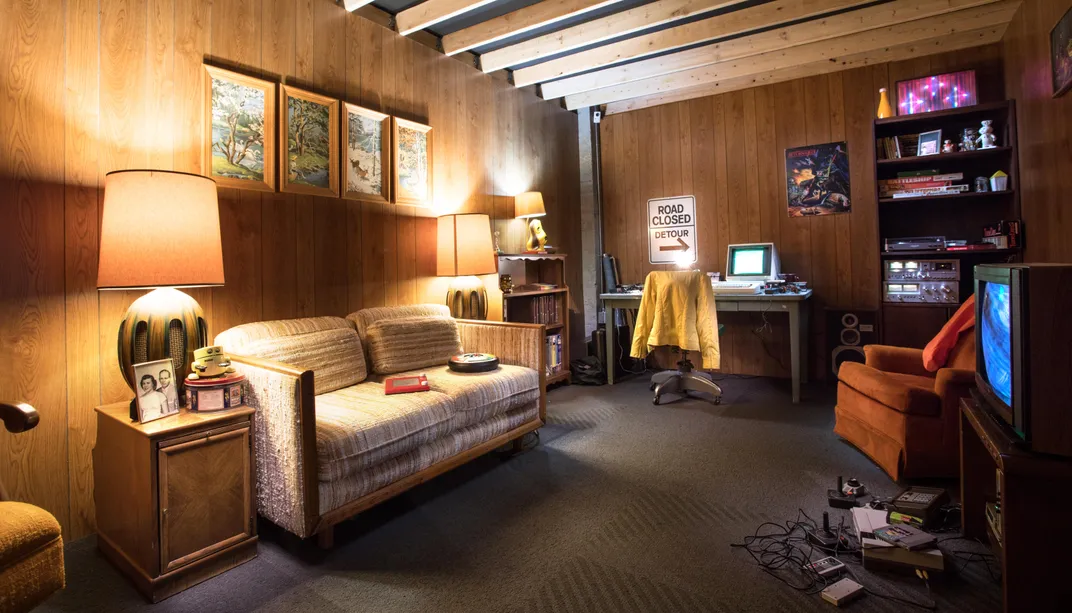
Earlier this year, Carlson oversaw the museum's most ambitious temporary exhibit yet, “Totally 80s Rewind.” Stocked with usable computers, it recreates an '80s classroom, video game arcade and basement rec room. It's open through December 31, after which the museum will add 2,000 square feet of climate-controlled floor space for more mainframe computers.
Few people save old computers the way they save vintage motorcycles and antique furniture. To most, computers didn't become classics. They just became old. Even though the world bought its one billionth computer by 2002, according to the market research firm Gartner Dataquest, many had already gone into landfills. Here are just a few of the machines—all responsible in one way or another for major steps on the computer's evolution from whole-room laboratories to the desk and into the pocket—that LCM+L chose for its collection.
NorthStar Horizon
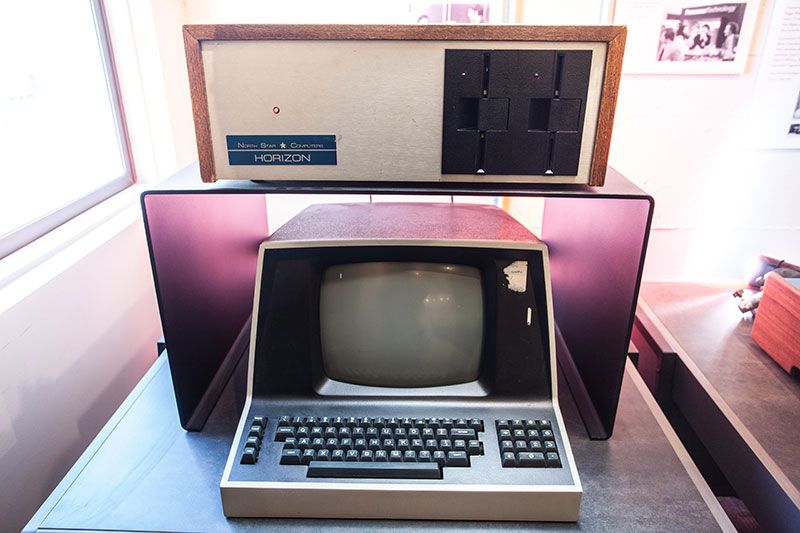
Like every other manufacturer of personal computers in 1977, NorthStar was a small startup. Founded as Kentucky Fried Computers, it took less time to get sued into a name change than it does to order a five-dollar fill-up box. Consumers either bought the wood-encased Horizon as a kit for $1,600 (equal to $6,600 in 2018) and assembled it themselves, or paid an extra $300 to buy it complete. It was one of the first microcomputers, as personal computers were then called, to come with optional 18mb hard drive and 5 1/4” floppy disk drive(s) integrated into the hardware inside the cabinet, rather than as an add-on peripheral. Both storage devices were more convenient than bulky magnetic-tape cassettes and inconvenient paper punch cards, on which data was “saved” by punching holes in a numbered card that could later be read by a computer.
Tandy 1000
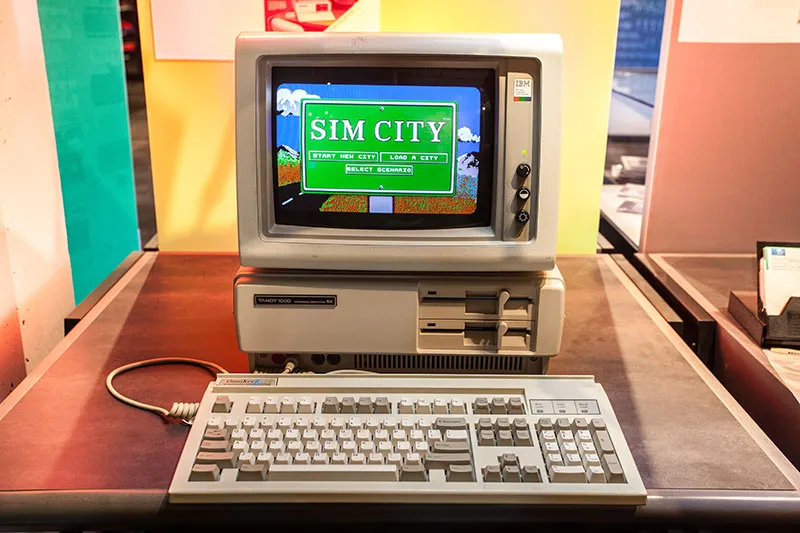
The Tandy 1000's claim to fame was that it beat IBM at its own game for less money. Tandy, a Texas-based leather goods company that owned RadioShack, had struck it big in 1977 with its first home computer, the cheap and popular TRS-80. But the computer industry was moving quickly, and when it began to standardize in the early '80s the TRS-80 could no longer cut it. IBM was slow to enter the personal computer market. By 1980 it decided to finally built one – in a hurry. To speed development IBM assembled its the microcomputer – called simply the IBM PC – out of third-party hardware and software, which opened the door for competitors to build computers that could piggyback off the PC's fast-growing reputation and popularity.
By 1984, after three years of the PC locking down much of the market, Tandy released the 1000. Tandy advertised it as a fully IBM-compatible machine that could do everything the PC could do for $1,000 less, and sold it in its 3,000 RadioShack stores. Other competition in its price bracket – Apple, Atari, and Commodore – weren't IBM compatible. Visitors can play many of the late 1980s' most popular games, now considered classics of video games' golden age, including Wheel of Fortune and Maniac Mansion. “RadioShack understood the home computer market more than most,” says Aaron Alcorn, curator at LCM+L. Stores were on street corners everywhere across the country, and so customers could get accessible service face-to-face, from buying advice to long-term technical support. RadioShack sold only Tandys until the Texas computer company quit the business in 1993.
Xerox Alto
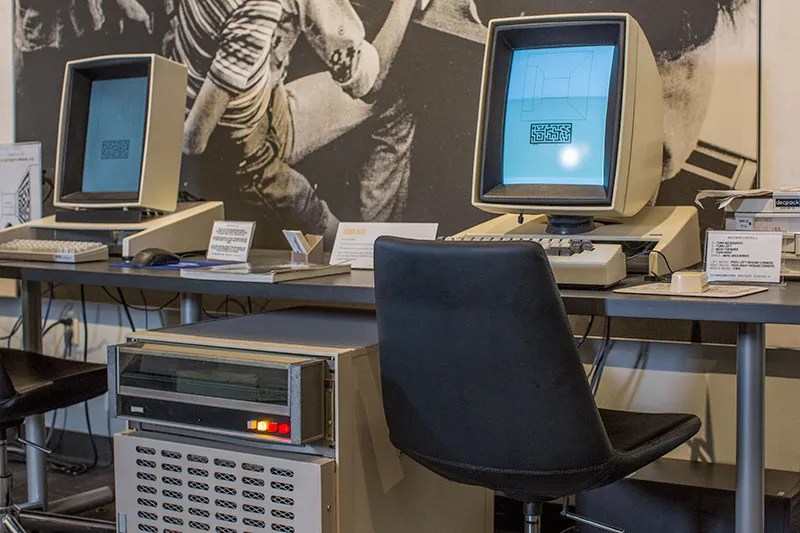
“The Alto was, in effect, a prototype of what would become the personal computing devices we use every day,” says Josh Dersch, the museum's senior vintage software developer. It had all the familiar elements, decades beforehand: local processing, local storage, a GUI with keyboard and mouse, and networking to connect it with other computers. It was also an expensive computer, costing $12,000 (equal to $71,000 in 2018), but one that had a huge impact in Silicon Valley.
Visitors get to use one of the earliest examples of a new technology strange and rare in the early '70s—the mouse—and try their hand at SmallTalk, an early programming language.
The Alto was an experiment in GUIs, the first such computer designed from the outset for an interface that relied on a mouse interacting with menus, icons and windowed programs rather than simply lines of text. It was also the origin of Ethernet networking, says Rich Alderson, the museum's senior systems engineer. Xerox foresaw the future office as paperless, and therefore its computers would need a way to pass information without printing paper. Drawing ideas from the then-three-year-old ARPANET (forerunner of the Internet) and the University of Hawaii's brand-new ALOHAnet, Xerox created the coaxial-cable-based connectivity system we still use today.
Apple II
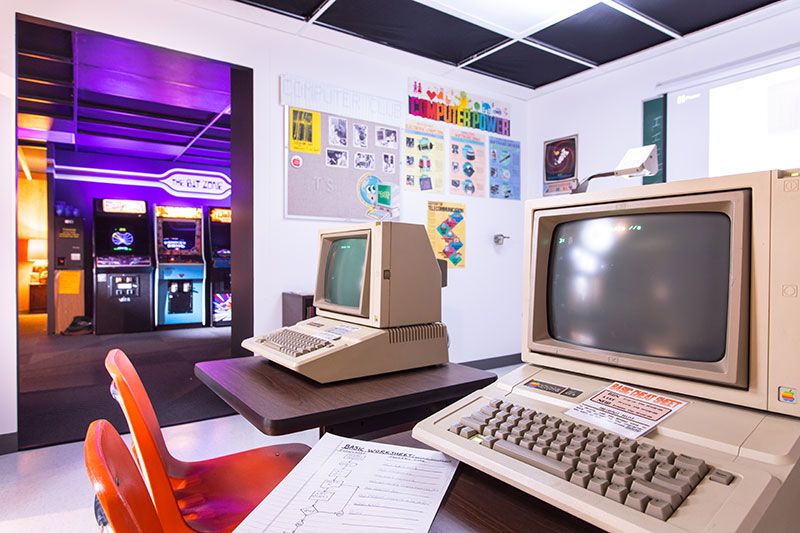
Even in 1977, Apple was obsessed with design. Its upcoming Apple II was to be the first personal computer aimed at casual home users rather than techy hobbyists or businesses, and it had to look the part. Where its utilitarian competitors left electronics and switches hanging exposed, the Apple II hid all its hardware inside a molded plastic case that encompassed the keyboard, on which sat an equally slick plastic-wrapped monitor.
Contemporary reviewers were effusive about the Apple II's standard color graphics. People didn't have to buy add-on graphics cards to see color. Knowing that all Apple II owners had color encouraged programmers to incorporate it not only into games but also text-based programs, such as spreadsheets. Other aspects, though, were off to a shaky start. For half a year the Apple II used finicky magnetic-tape cassettes for storage, and then Apple released the Disk II, a plug-in peripheral of two 5 ¼” floppy disks. “This was the point at which the Apple II became truly useful,” Alderson says, “allowing programs and data to be shared easily, and a nascent software business to expand greatly.” The Apple II, modified and updated continuously, was kept in production until 1993, an incredible lifespan for any personal computer of any era, even in the 21st century. There's an extensive library of games for visitors, including the original Oregon Trail, and work software, such as VisiCalc. Released in 1979 as the first spreadsheet program, VisiCalc had a major hand in turning the personal computer into a serious business tool. “What can't you do with an Apple II?,” asks Carlson rhetorically.
Control Data Corporation CDC 6500
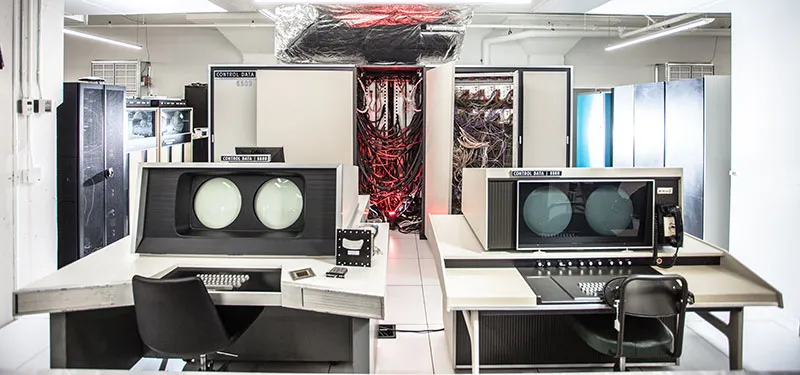
Seymour Cray, famous supercomputer designer, aimed the 6000 series at serious research institutions who needed to do hardcore number crunching, rather than small-business applications. The 6500 cost $8 million when it debuted, equal to $60.5 million in 2018. The first 6600, part of the same computer family as the 6500, went to Lawrence Livermore National Labs in 1964 to design nuclear weapons and simulate the inside of the sun. Boeing used a 6600 to design airplanes, and General Motors used one to design cars. The liquid-cooled 6500 weighed 3,800 pounds and, along with the operator console, took up 300 square feet. But total installation required 5,000 to 10,000 square feet for all the tape drives, disk drives and peripherals that plugged into it.
Hardware on older computers such as the CDC 6500 is more accessible than later machines, says Carlson, and a good teaching tool. Visitors can handle the CDC 6500's core memory modules to see the magnets used for storing information. Every little magnet is a single bit of memory stored as either a 1 or 0, comprising a basic system known as binary code. The parts have shrunk, but we still use binary today.
“The CDC 6500 was so cutting-edge when they were built it that it required a team of engineers around the clock to keep it going,” Carlson says. In a best-case scenario, the CDC 6500 was fully functional 60 to 70 percent of the time. It's the museum's most finicky computer, stored with the other large machines in a special room on the second floor. The floor tiles are perforated in places so air conditioning can cool the systems from below, and they conceal the massive, snaking power and system cables needed to run the computers., It took over two years to get the CDC 6500 working after LCM+L bought theirs. Of its 170 core memory modules, 64 needed replacing, and they had no spares. “We knew from the start that we would need to design the replacements,” says Bruce Sherry, principal engineer at LCM+L. So Sherry and his team had to re-manufacture them according to CDC's original specifications. And then there are the 250,000 separate transistors, of which any one failure can shut the computer down. “(The 6000s) were not overly reliable,” Sherry says, “but users would say an hour on a CDC was worth a whole day on an IBM.”
Digital Equipment Corporation PDP-8/e
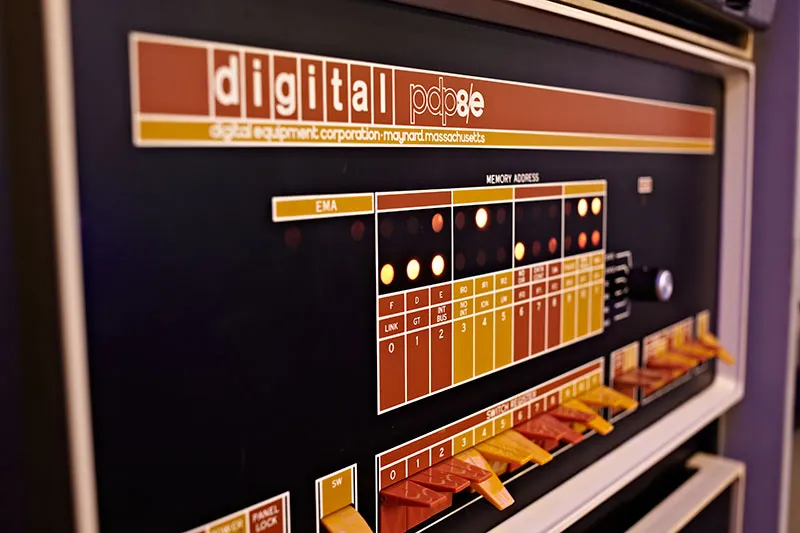
The PDP-8, which entered the market in 1965, was one of the first minicomputers. Not mini by today's standards, but mini compared to the mainframes and supercomputers of the time, the PDP-8 was about a foot tall, and when coupled with a disk drive and tape drive it took up only a six-foot-tall storage rack. The fast evolution of its price tag shows how rapidly computing fell into the mainstream in the late '60s—if not for individuals, then for institutions and companies. When it went on sale in 1965, it cost $16,000, equal to $127,500 in 2018. Shortly after the 8/e model came out in 1970, DEC reduced the price to $4,995 ($32,500 in 2018), the first computer to ever sink below the $5,000 mark.
“It was built by engineers for engineers,” says Alderson. Intended for laboratories and industrial manufacturing, the PDP-8's cheap price and small size led it to unexpected sales to schools for programming classes, hospitals for monitoring medical equipment and small businesses for keeping records. A PDP-8 ran the news display in New York's Times Square. Another ran the scoreboard at the Boston Red Sox's Fenway Park. By the time it went out of production in 1990, DEC had sold 50,000. One DEC engineer called it the “Model T of computing',” according to Aaron Alcorn. And just like the Model T, people came up with all kinds of unintended uses for it. Visitors' favorite thing to do on the PDP-8/e? Play chess.
Compaq DeskPro 386
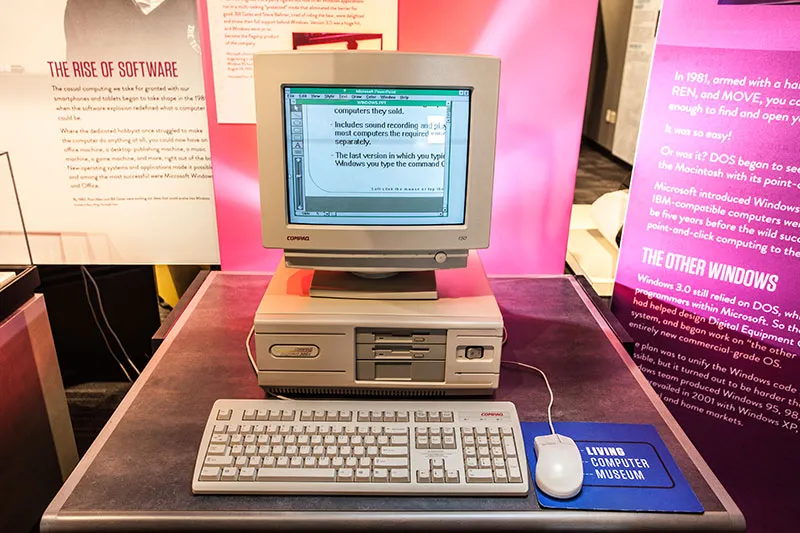
Significantly faster than any other personal computer in 1987, the 386 built Compaq's reputation as an IBM-killer. It took IBM seven months to release a competitor based on the same 32-bit Intel microprocessor, but by then the 386 was established as the high-performance business machine for intensive tasks, and no one—not even IBM—could catch up. Cutting-edge had a price: $6,500-8,000, equal to $15,000-$18,000 in 2018. Before the 386, high-end computing lived mostly on Unix-based operating systems, but the Compaq came with Windows/386, a GUI operating system based on the textual Microsoft MS-DOS used by IBM.
Developers, once dismissive of Windows, began to write more and more programs for it. Three years later with its breakthrough Windows 3.0, Microsoft began its domination of the OS market. Millennials and older visitors will be immediately familiar with the Windows 3.1 running on the museum's machine, as the OS was everywhere in the '90s. The 386 was also a pioneer of the workstation format, in which a high-performance business computer could fit on an employee's desk rather than remotely in the bowels of an office building. DeskPros today are hard to find. “Like most computers, when they outlived their usefulness they were scrapped,” says Dersch.